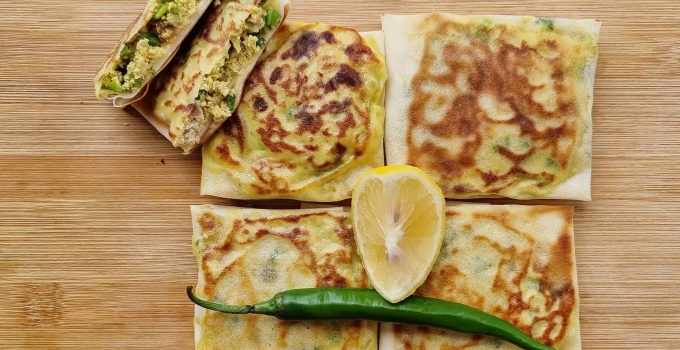Mutabbaq, a delectable Middle Eastern dish, offers a tantalizing blend of flavors and textures that have captivated taste buds for centuries. Originating from the Arabian Peninsula, this savory treat has gained popularity across the globe, delighting food enthusiasts with its irresistible combination of spices, fillings, and crispy layers. Let’s embark on a culinary journey to discover the richness and charm of Mutabbaq.

Mutabbaq
Contents
A Culinary Heritage:
Mutabbaq traces its roots to the rich culinary traditions of the Arabian Peninsula, where it has been enjoyed for generations as a beloved street food and homemade delicacy. Its name, which means “folded” or “layered” in Arabic, aptly describes its distinctive preparation method, wherein thin layers of dough are folded over a savory filling before being pan-fried to golden perfection.
Ingredients and Preparation:
The key ingredients in Mutabbaq include flour, water, salt, and oil for the dough, as well as a variety of savory fillings that can range from spiced meats and vegetables to cheese and eggs. The dough is rolled out into thin rounds, layered with the chosen filling, and folded over to encase the filling completely. The filled dough is then cooked on a griddle or skillet until crisp and golden on both sides, resulting in a mouthwatering creation that is crispy on the outside and deliciously savory on the inside.
Variations and Regional Influences:
While the basic concept of Mutabbaq remains consistent, there are numerous regional variations and adaptations that reflect the diverse culinary landscape of the Middle East and beyond. In some regions, Mutabbaq is served as a sweet dessert, filled with ingredients such as nuts, honey, and spices. Other variations may feature unique fillings and flavor combinations that reflect local tastes and traditions.
Serving and Enjoyment:
Mutabbaq is typically served hot and fresh off the griddle, allowing diners to savor its irresistible aroma and flavors. It is often enjoyed as a standalone snack or appetizer, accompanied by a refreshing beverage such as mint tea or yogurt-based drinks. Mutabaq can also be served as part of a larger meal, paired with salads, dips, and other Middle Eastern delicacies for a complete dining experience.

Mutabbaq
Cultural Significance:
Beyond its culinary appeal, Mutabbaq holds cultural significance as a cherished dish that brings people together to share laughter, stories, and good food. Whether enjoyed during festive occasions, family gatherings, or casual outings with friends, Mutabaq embodies the spirit of hospitality and conviviality that is deeply ingrained in Middle Eastern culture.
Mutabbaq stands as a testament to the culinary creativity and cultural richness of the Middle East, offering a tantalizing fusion of flavors, textures, and aromas that delight the senses and warm wdbos the soul. Whether enjoyed as a street food snack, homemade treat, or gourmet delicacy, Mutabaq continues to captivate food enthusiasts around the world with its timeless appeal and irresistible charm.
Exploring the Pros and Cons of Mutabbaq: A Middle Eastern Culinary Delight
Mutabbaq, a beloved Middle Eastern dish renowned for its crispy layers and savory fillings, offers a delightful culinary experience that has captivated food enthusiasts worldwide. While it boasts numerous strengths that contribute to its popularity, Mutabbaq also presents certain drawbacks that warrant consideration. Let’s delve into the advantages and disadvantages of this delectable delicacy.
Advantages of Mutabbaq:

Mutabbaq
- Versatility in Fillings: One of the greatest strengths of Mutabaq is its versatility in fillings. From savory options like spiced meats, vegetables, and cheese to sweet variations featuring nuts, honey, and spices, Mutabbaq offers a wide range of flavor combinations to suit diverse palates and preferences.
- Portability and Convenience: Mutabbaq’s handheld nature makes it a convenient and portable snack or meal option, perfect for on-the-go consumption or casual dining occasions. Its compact size and easy-to-eat format make it a favorite choice for street food vendors and busy individuals seeking a satisfying bite.
- Crispy Texture and Flaky Layers: Mutabbaq’s signature crispy texture and flaky layers are a testament to its expertly crafted dough and cooking technique. The contrast between the crisp exterior and tender interior adds depth and complexity to each bite, creating a truly indulgent eating experience.
- Cultural Significance: Mutabaq holds cultural significance as a cherished dish that is deeply rooted in Middle Eastern culinary traditions. It is often enjoyed during festive occasions, family gatherings, and celebrations, serving as a symbol of hospitality, togetherness, and shared enjoyment.
Disadvantages of Mutabbaq:
- High Caloric Content: Due to its doughy exterior and rich filling, Mutabaq can be high in calories, fat, and carbohydrates. Consuming Mutabbaq frequently or in large quantities may contribute to weight gain and other health issues if not consumed as part of a balanced diet.
- Potential for Greasiness: Depending on the cooking method and ingredients used, Mutabaq has the potential to be greasy or oily, which may detract from its overall appeal and perceived healthfulness. Excessive grease can also lead to digestive discomfort for some individuals.
- Limited Nutritional Value: While Mutabbaq is a flavorful and satisfying dish, it may lack the nutritional value found in more balanced meals. Its predominantly starchy and fatty composition may not provide essential nutrients such as vitamins, minerals, and dietary fiber in sufficient quantities.
- Allergen Sensitivity: Some individuals may have allergies or sensitivities to certain ingredients commonly used in Mutabaq fillings, such as nuts, dairy, and gluten. Care should be taken to identify and accommodate dietary restrictions and preferences when preparing or consuming Mutabbaq.
Conclusion:
Mutabbaq offers a tantalizing blend of flavors, textures, and cultural significance that has made it a beloved dish in Middle Eastern cuisine. While its versatility, portability, and cultural appeal are undeniable strengths, it is important to be mindful of its potential drawbacks, including its high caloric content, greasiness, limited nutritional value, and allergen sensitivity. By enjoying Mutabaq in moderation and as part of a balanced diet, individuals can fully appreciate its deliciousness while minimizing its potential impact on health and well-being.
Read More Article About “Gourmet Grilling: Elevating Your Outdoor Cooking Experience“



